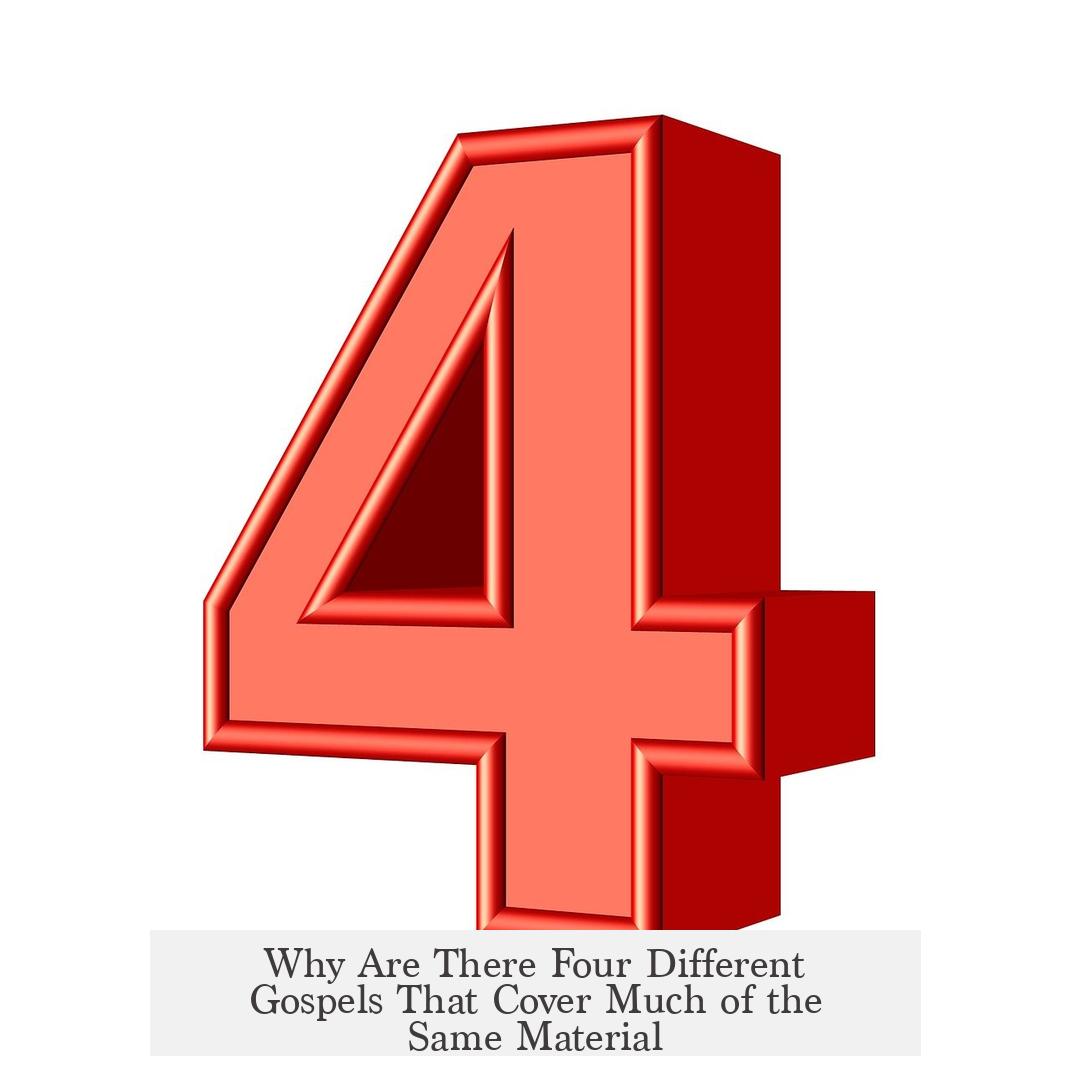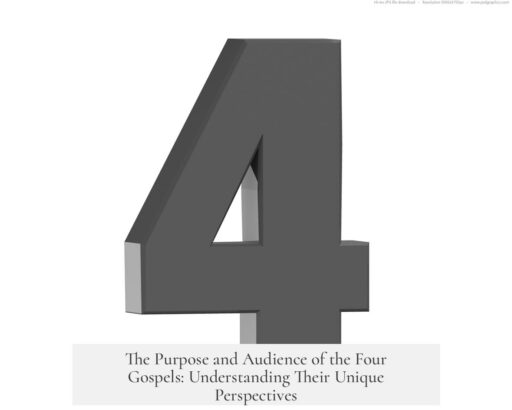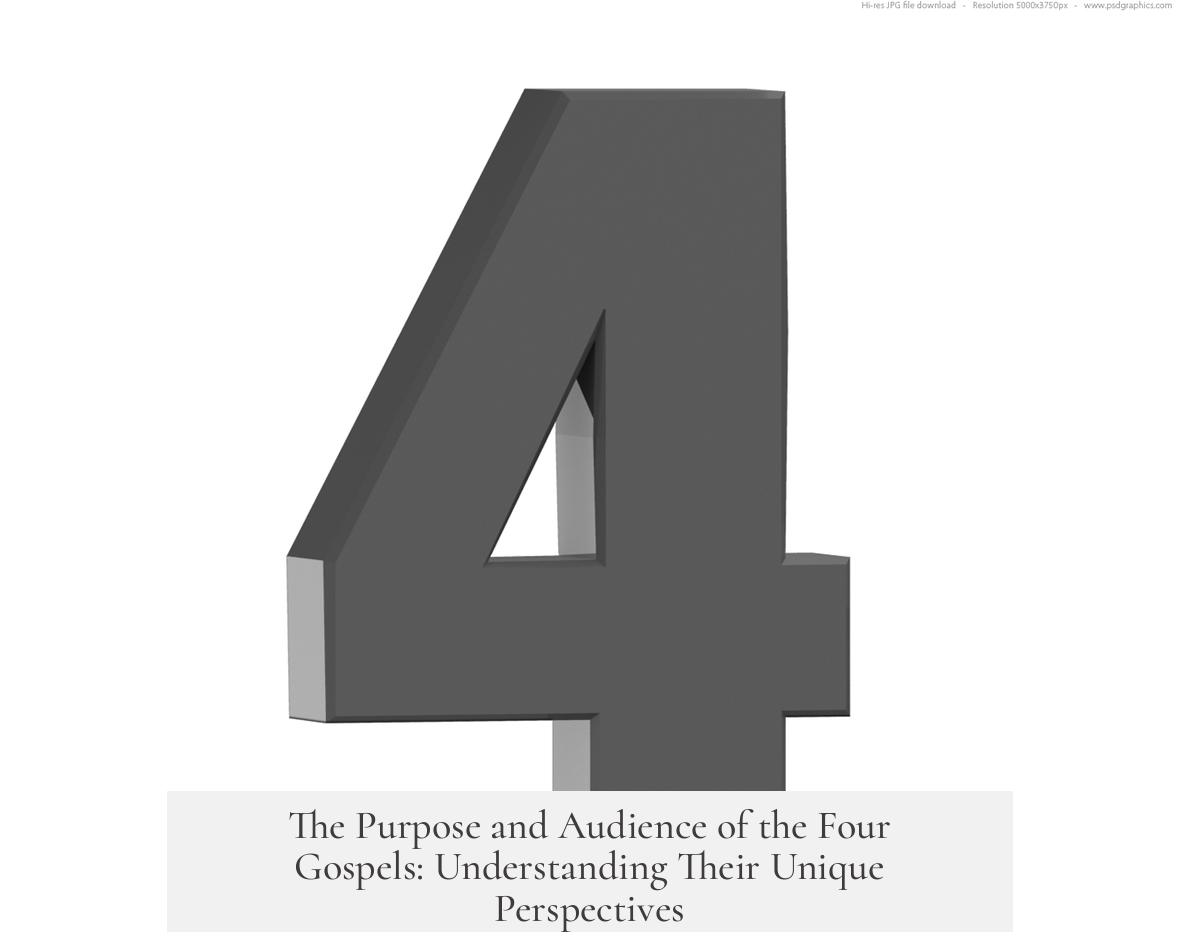Four different Gospels exist because each was written with distinct purposes and audiences in mind, reflecting varied perspectives on Jesus’s life and teachings. These writings overlap in content but emphasize different aspects of Jesus’s identity and message. Matthew, Mark, Luke, and John each present a unique narrative style, theological focus, and cultural context, offering a composite yet diverse portrait of Jesus.
The four Gospels were composed between roughly 60 AD and 100 AD, decades after Jesus’s death. Mark is generally accepted as the earliest, written in the late 60s or early 70s. Matthew and Luke followed in the 80s or 90s, while John was likely composed near 100 AD. This timeline explains why they share much material but also show notable differences.
Mark, Matthew, and Luke are called the Synoptic Gospels due to their overlapping content and similar chronological structure. The academic consensus holds that Mark was the first Gospel written. Matthew and Luke appear to have drawn on Mark and an additional, now-lost source commonly referred to as “Q” (from the German “Quelle,” meaning “source”). Both Matthew and Luke included unique traditions besides Mark and Q.
- Mark focuses on the humanity of Jesus, portraying him as a suffering servant and emphasizing his actions and struggles.
- Matthew emphasizes Jesus as the fulfillment of Jewish law and prophecy, portraying him as a new Moses and addressing a primarily Jewish-Christian audience.
- Luke presents a more Gentile-friendly (Greek) version, highlighting Jesus’s compassion and universal salvation, likely addressed to non-Jewish converts and God-fearers interested in Judaism.
John differs significantly. It is not synoptic and contains lengthy philosophical discourses not found in the other Gospels. This Gospel highlights the divinity of Jesus far more explicitly than the others, depicting him as the eternal Word (Logos) and Son of God. Most scholars believe John targeted a primarily Jewish-Christian community seeking a theological explanation of Jesus’ identity.
The intended audiences influenced the style and content of each Gospel. Matthew’s text assumes knowledge of Jewish customs and scriptures but does not explain them, indicating a Jewish readership. It presents Jesus as fulfilling Old Testament prophecies to affirm Jewish expectations of the Messiah.
Luke explicitly addresses a figure named Theophilus, presumed to symbolize a Gentile Christian or God-fearer. His Gospel carefully constructs a historical and orderly account, written in polished Greek and tailored to readers familiar with Hellenistic culture and the Greek translation of the Hebrew Bible (the Septuagint).
Mark’s audience appears to be a local Christian community facing persecution, possibly in Roman Syria or Rome. Its narrative is concise and urgent, meant to reinforce faith during trials. Mark includes specific references to individuals and places that only local listeners would likely recognize.
John’s Gospel is theological and reflective, aiming to deepen belief in Jesus as the Messiah and divine Son. It intentionally differs through symbolic language and aims to promote a mystical understanding of Jesus beyond historical biography.
The existence of four Gospels with overlapping but sometimes conflicting details highlights their distinct perspectives rather than a contradiction or error. The earliest Christians valued preserving multiple portrayals of Jesus to reflect diverse experiences and teachings within early Christian communities. Together, these Gospels provide a fuller picture of Jesus’s life, mission, and significance.
| Gospel | Date | Audience | Purpose/Focus |
|---|---|---|---|
| Mark | ~60-70 AD | Local Christian community, possibly Roman Syria | Portray Jesus’s humanity; encouragement amid persecution |
| Matthew | ~80-90 AD | Jewish Christians | Present Jesus as Messiah fulfilling Jewish law and prophecy |
| Luke | ~80-90 AD | Gentile Christians and God-fearers | Universal salvation; historical account for educated Greek audience |
| John | ~90-100 AD | Jewish Christian community | Emphasize Jesus’s divinity and theological meaning |
The Gospels offer different versions and emphases. This plurality enriches understanding rather than undermining it. The goal is to grasp the core message of Jesus’s teachings and works, not to resolve every discrepancy.
- Four Gospels exist because each serves a different community and purpose.
- Mark, Matthew, and Luke share sources; John stands apart both in content and style.
- Mark highlights Jesus’s humanity for a persecuted Christian audience.
- Matthew addresses Jewish Christians, stressing fulfillment of the Old Testament.
- Luke speaks to Gentile believers, presenting a universal and orderly narrative.
- John focuses on Jesus’s divinity and deep theological reflection.
- Multiple perspectives convey a richer, more nuanced understanding of Jesus.
Why Are There Four Different Gospels That Cover Much of the Same Material?

The simple answer is this: there are four different Gospels because each was written for a unique audience, with a distinct purpose, presenting Jesus through different lenses and cultural frames. They overlap in stories but highlight varied themes, teachings, and theological emphases.
In other words, these Gospels want you to *see* Jesus from multiple angles—not just one snapshot. Each Gospel author writes with a specific community and purpose in mind, creating a richer, multi-faceted portrait. Let’s dive into why that matters and who’s the intended audience of each Gospel.
The Timeline and Sources: Mark, Matthew, Luke, and John
First, some context. No Gospel was penned while Jesus was still strolling through ancient Palestine. Scholars generally date Mark, the earliest, to around 60-70 AD. Matthew and Luke followed in the 80s or 90s. John arrives last, about 100 AD. This timing is essential because it means each author was reflecting on Jesus’ life years after the events, shaped by their communities’ needs.
The first three—Mark, Matthew, and Luke—are called the Synoptic Gospels. “Synoptic” means “seen together,” because they have a lot in common: similar stories, events in roughly the same order, and much overlapping material. Most scholars think Mark wrote first. Then Matthew and Luke drew on Mark and on a now-lost collection of Jesus’ sayings called “Q” (from the German “Quelle” for “source”).
But John stands apart. Over 90% of John’s content doesn’t appear in the Synoptics. John’s style is more abstract and philosophical. It’s like the difference between a documentary film and a poetry reading. So John provides a unique flavor altogether.
Mark: The Human Jesus for a Persecuted Community
Mark’s Gospel zeroes in on Jesus’ humanity. His stories are brisk, action-packed, and at moments, somber.
Mark likely wrote for a local Christian group facing persecution—possibly in Roman Syria or even Rome itself. This audience was probably already believers wrestling with hardship.
Why does this matter? Because Mark’s focus is on Jesus as a suffering servant who endures pain and calls his followers to courage. The Gospel lacks lengthy explanations of Jewish customs, probably because most of Mark’s readers had limited familiarity with Judaism.
Through Mark’s narrative, early Christians received pastoral support—they were reminded who Jesus was, what his mission entailed, and what it meant to live in “the Kingdom of God” despite hardship. It might have been a comforting liturgical text, helping believers hold fast during tough times.
Matthew: Jesus as the Fulfillment of Jewish Hope
Matthew has a distinctly Jewish flavor. This Gospel portrays Jesus as the fulfillment of Old Testament prophecy and law. Unlike Mark, Matthew often references Hebrew Scriptures and applies rabbinic teaching methods.
It’s likely Matthew wrote for Jewish Christians in places like Antioch in Syria. These were people coming from a Jewish background, needing help reconciling Jesus with their traditions.
Matthew’s purpose appears to be a discipling manual. It reassures Jewish believers that Jesus isn’t a breakaway figure but the promised Messiah. The Gospel includes extensive teachings, sermons, and controversy with Jewish critics.
For example, Matthew refutes claims that Jesus was illegitimate or that his body was stolen post-crucifixion—addressing concerns circulating in Jewish communities.
Luke: A Gentile-Friendly Account For a Greek-Speaking Audience
Luke’s Gospel stands out as the most inclusive. Often called the “Gentile Gospel,” it presents Jesus as a savior universally accessible, emphasizing compassion, mercy, and outreach to marginalized groups.
Luke’s intended audience was likely educated Gentiles familiar with Greek culture—possibly “God-fearers” who admired Judaism but had not fully converted. His writing reflects an orderly style, aiming to persuade Theophilus—perhaps a patron or representative believer—of the truth about Jesus.
The Gospel includes stories absent from others: the Good Samaritan, the Prodigal Son, and warm encounters with marginalized people like women and Gentiles.
Luke aims to bridge cultural divides, making Christianity palatable and meaningful to those outside Judaism.
John: The Philosophical and Divine Jesus
John’s Gospel is the philosophical big sibling. It presents Jesus as the eternal Word, the divine Logos who existed before creation. Its tone and content differ wildly from the Synoptics.
Written around 100 AD, most likely in Ephesus or another Roman Asian city, John addresses a mostly Jewish Christian community steeped in Palestinian traditions and struggling with how to understand Jesus’ divine nature.
John’s stated purpose is to help readers believe Jesus is “the Messiah, the Son of God,” so believers may “have life in his name.” Whether it’s aimed at insiders or outsiders—or both—is unclear, but it emphasizes faith and eternal life.
Its sermons are long, theological, and poetic—a far cry from the punchy style of Mark. Many episodes—like the “I am” statements—appear only in John.
The Takeaway: Why Four Gospels, Not One?
The existence of four official accounts gives Christianity dynamic breadth:
- Multiple witnesses: each Gospel provides a different testimony that, taken together, form a fuller picture.
- Theological depth: each author emphasizes different qualities of Jesus—his humanity, messianic fulfillment, inclusive salvation, or divine nature.
- Audience relevance: addressing the diverse cultural backgrounds and challenges in early Christian communities.
Want just one version? You miss out on the rich tapestry of perspectives.
Do the Gospels always agree perfectly? No. They sometimes contradict in details or emphasize different events. This diversity opens doors to profound reflection and analysis rather than locking readers into one rigid narrative.
What Can We Learn Today?
We can appreciate how the early Church responsibly handled its traditions in multiple ways, crafting messages tailored to different believers. If you’re a Bible reader, knowing the intended audience and purpose behind each Gospel can shape how you understand them.
For example, encounter Matthew when wrestling with faith traditions and religious law. Turn to Luke when seeking an expansive, inclusive story that embraces the outsider. Dive into Mark for a raw, immediate portrait of Jesus’ humanity in suffering times. Let John inspire you with theological insight on Jesus’ divine identity.
Each Gospel can challenge, comfort, or teach you—depending on what you need.
Final Thoughts: Embrace the Fourfold Portrait
So, why four Gospels? They tell overlapping stories from different angles, shaped by their audiences: persecuted Christians, Jewish believers, Greek-speaking Gentiles, and deep theological communities. Together, they resist flattening Jesus into a single stereotype, instead presenting a multi-dimensional figure whose life and message speak to many walks of life.
Next time you read the Gospels, ask yourself: Which author am I “listening” to today? Which message do I need? The Four Gospels invite you not just to read history, but to engage with a living tradition, seen through diverse eyes but centered on one compelling figure.
| Gospel | Date (Approx.) | Audience | Purpose/Focus | Distinctive Feature |
|---|---|---|---|---|
| Mark | 60-70 AD | Local Christian community (likely persecuted) | Highlight Jesus’ Humanity & Suffering; Encouragement during hardship | Fast-paced narrative; no lengthy Jewish customs explanation |
| Matthew | 80-90 AD | Jewish Christians | Show Jesus as Jewish Messiah fulfilling Old Testament prophecies | Strong Old Testament references; Aramaic origins; rabbinic style |
| Luke | 80-90 AD | Gentile Christians and God-fearers (educated Greek speakers) | Present Jesus as Savior for all peoples; inclusive and orderly account | Unique parables (e.g., Good Samaritan); Greek cultural references |
| John | ~100 AD | Jewish Christians with deep theological knowledge | Emphasize Jesus’ Divinity and eternal life through faith | Theological sermons; “I am” statements; high Christology |
In sum, the four Gospels are not competing narratives but complementary windows. They invite readers to explore faith with nuance and depth, reflecting the many hues of the early Christian experience.




